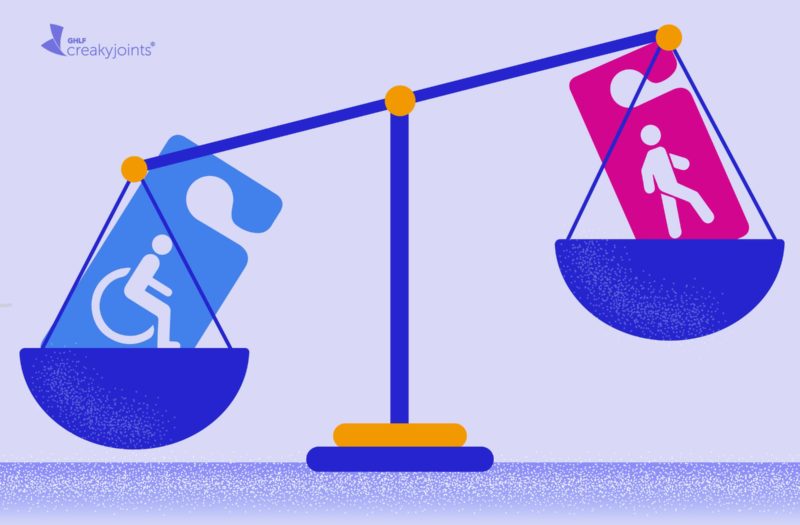I am a wife, sister, auntie, friend, writer, editor, leader, consultant, advocate, patient, and much more. These are all labels that apply to me. Is “disabled” one of them?
Maybe.
To help me write this piece, I decided to see if I could find a universal definition of the term “disability.” It turns out there isn’t one.
What Does ‘Disability’ Mean?
Most organizations use definitions along the lines of: “a limitation, restriction, or impairment that limits a person’s ability to participate in everyday activities or employment.” The term is often further broken down according to the degree of disability, from mild to severe. While those definitions all seem reasonable, they are also vague and open to interpretation.
Some definitions include comparisons with other people. The Cambridge Dictionary lists one definition as: “an illness, injury, or condition that makes it difficult for someone to do the things that other people do.” To me, that is way too subjective. Other people play drums or competitive sports. I find these difficult, regardless of the state of my body. Yet, there are many people with permanent physical or mental limitations who can do these things with outstanding skill. They may not even call themselves disabled.
Other definitions state that, to be considered disabled, the person needs to be affected for a minimum period of time, such as six months or one year. These are usually for government or insurance purposes, including disability pension applications.
Again, I don’t think disability is that black and white. If a person tragically loses a limb in a car crash, does that mean they are not considered disabled until one magical day a year later? What about chronic conditions like rheumatoid arthritis or axial spondyloarthritis? I have both of these plus other conditions that fluctuate in severity and can go into and out of remission. They don’t follow a linear timeline.
One heading that stood out to me while doing my online search for a definition was, “How We Decide If You Are Disabled?” What the …?
True, this came from the U.S. Social Security Administration website and I understand that they need strategies to determine who gets covered or not. However, my instinctive reaction when I read it was, “Who are you to decide if I am disabled or not?” I’m not even sure myself, so what gives you the right to judge me?
Visible Versus Invisible Disabilities
Another problem with defining disabilities is that some are plainly visible while others are what many in the chronic illness community call invisible. Yet, even invisible disabilities are visible to those who care to notice them. It could be the time it takes to get out of bed, a reduction in social activities, no longer wearing shoes you love because they’re uncomfortable, a mild limp or gait change.
There are many subtle signs that can indicate that something is not right.
A popular misconception is that people need to have a visible impairment or use aids or equipment (like a cane) to be considered disabled. (This is most noticeable when someone with an invisible disability gets abused for using an accessible parking spot.) Do they think an otherwise healthy person with an artificial leg is more disabled than me? Is there a fair answer to that?
I’m also not sure which is better or worse: having a disability that is so visible that people stare at you in the street or one that is so invisible that people don’t believe you and accuse you of faking it. People across this whole spectrum often experience discrimination and a lack of understanding from others.
My conditions currently sit somewhere between the two extremes.
Do I Identify as Disabled: Yes or No?
There are many factors that influence my answer. Here are a few of them.
On the “yes” side:
- I qualified for a partial government disability pension (I am from Australia).
- I can’t work in a “regular” job because my health conditions are too unpredictable.
- I sometimes use a shower chair and other daily living aids.
- I now have a walking stick that I use when I need it for sciatica.
- I can’t bend or squat for more than a few minutes at a time so I now pay for a gardening service.
- I often have days where I struggle to do much because of pain, fatigue, or brain fog.
On the “no” side:
- I can supplement my income by working from home as a freelance writer (mainly for CreakyJoints Australia and CreakyJoints) and choosing my own hours.
- I can usually manage all of my self-care and household activities without aids or assistance.
- Until very recently, I’ve been able to walk without assistance of any kind.
- I can do a weekly hatha yoga class as long as I modify some of the postures.
- I can drive a car and get myself around.
- I can do the supermarket shopping on my own.
- I can still go out with friends if I pace myself.
Even though many of these activities can cause me pain and fatigue, I can still do them. I have a choice. The truth is the severity of my conditions can vary from day to day and sometimes from hour to hour. So do I consider myself as disabled?
My conclusion is: sometimes.
And I am OK with that.
Would I change my situation if I could? Of course, I would prefer to have less pain, fatigue, and unpredictability as these are my main disablers, but I would not change my journey. It has helped me identify the things that are most important to me and I believe it has made me a better person, which I will be forever grateful for.
Not Sure What’s Causing Your Pain?
Check out PainSpot, our pain locator tool. Answer a few simple questions about what hurts and discover possible conditions that could be causing it. Start your PainSpot quiz.






